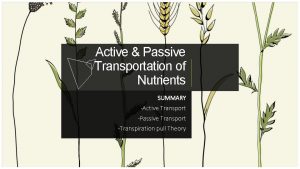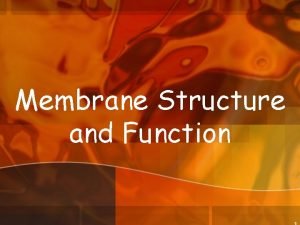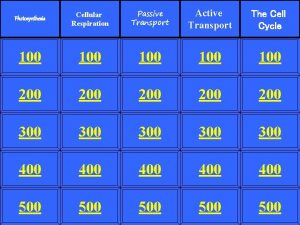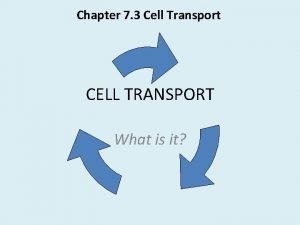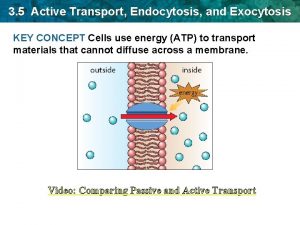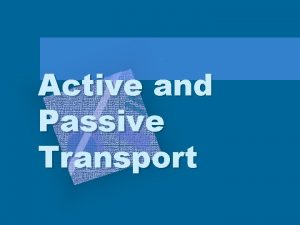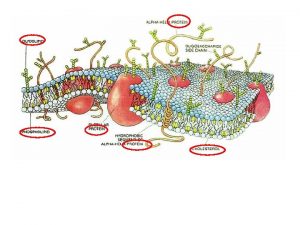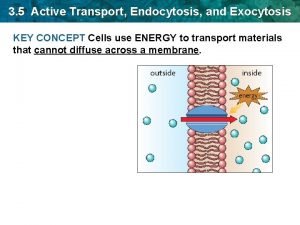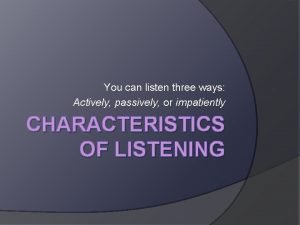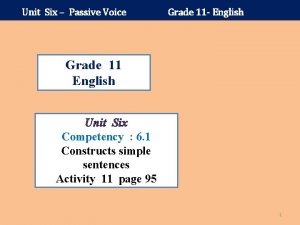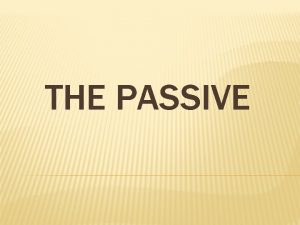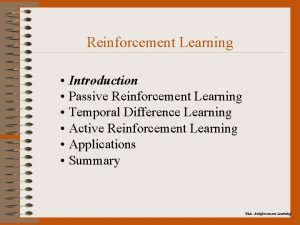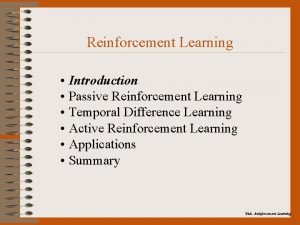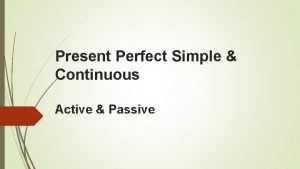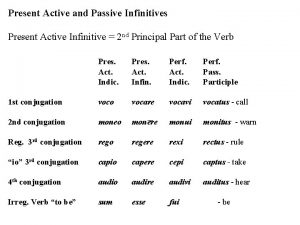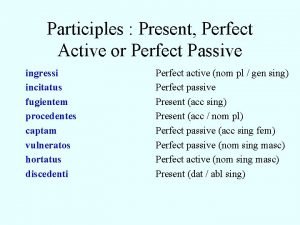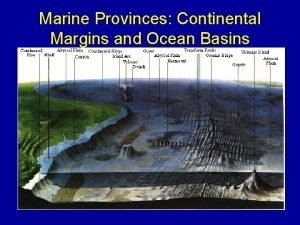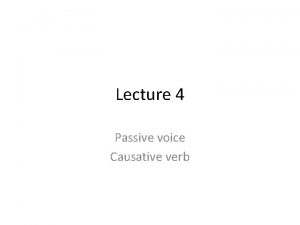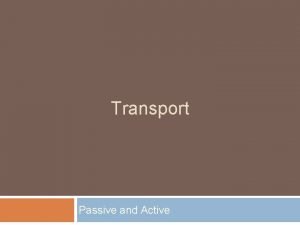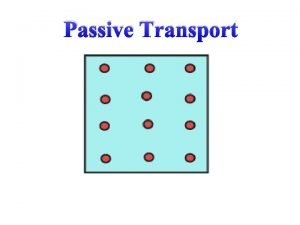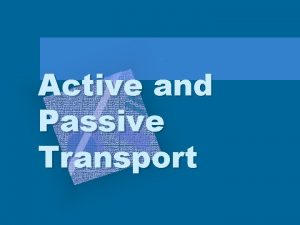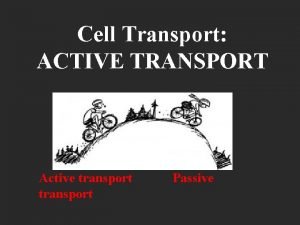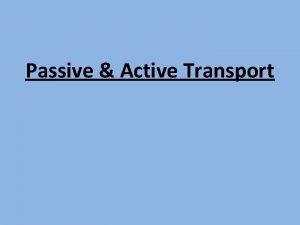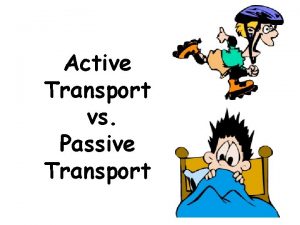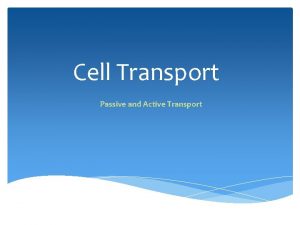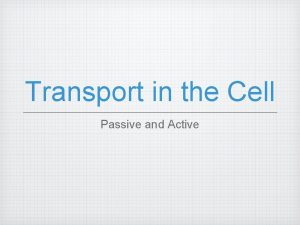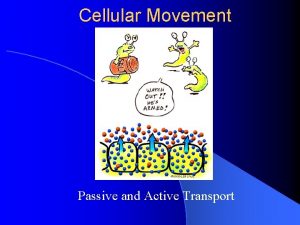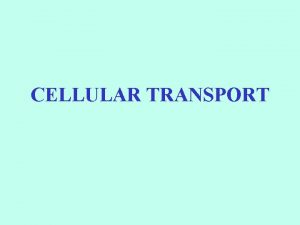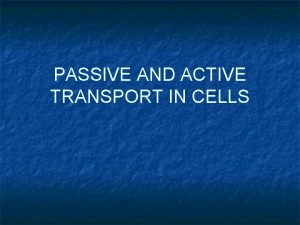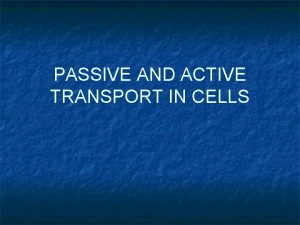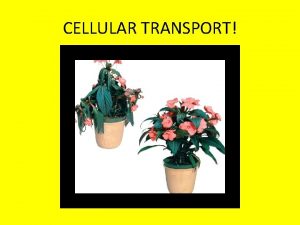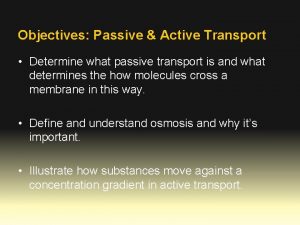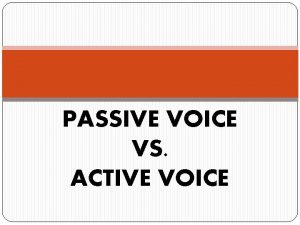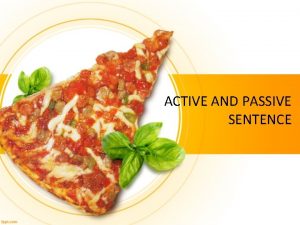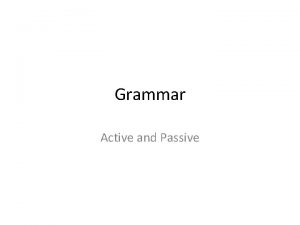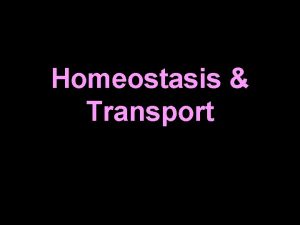Transport in the Cell Active and Passive Transport










































- Slides: 42

Transport in the Cell Active and Passive Transport

How can molecules move through cells? • Semi-permeable membrane: allows certain molecules to move in or out depending on their properties – Ex: if they are too big, they can’t go in easily • Membrane is made of (composition): – Bi-lipid layer • 2 layers of lipids – Proteins that transport materials across – Carbohydrates that act as identifiers

Fluid Mosaic Model-membrane is a fluid with a bunch of different components

Before we begin you must understand…. • Concentration-how much solute is in a solvent • Why must molecules move? – To maintain homeostasis – Homeostasis-state of balance in which the internal body remains in a normal range – Molecules must move to maintain this

Biology 11/5 HW-Concept Map 1. Take out 7. 3 wkst and 7. 3 notes. 2. Pick up your binder in the back. Put 7. 3 reading guide in wkst section.

2 types of transport in the cell • Passive transport – Molecules move down the concentration gradient • Area where there is a lot of molecules to where there is very little – Energy involved: NO • Active transport – Molecules move up the concentration gradient • Area where there is a few molecules to where there is a lot – Energy involved: YES

http: //www. brainpop. com/scie nce/matterandchemistry/diffusi on/ Username: cvbrainpop Password: cheetah 1

Type of Passive Transport Diffusion-movement of molecules from an area of high concentration to an area of low concentration until equilibrium is reached – Equilibrium-equal distribution • Molecules will move equally after this is reached. – Simple molecules can move • Carbon dioxide, oxygen

Passive transport

Osmosis-Type of passive transport • Water moves from an area of high concentration to an area of low concentration – No energy involved – AKA: diffusion of water

Hypertonic and Hypotonic • Hypotonic-More water outside the cell than inside – Distilled water – Water comes into the cell – Why? To balance out the concentration of solutes • Hypertonic-More water inside the cell than outside – Salt water – Water leaves the cell – Why? to balance out the concentration of solutes

Isotonic • Molecules are equal inside and outside the cell – Molecules move evenly across the membrane


Biology 11/14 HW-finish concept map Agenda: Stations; finish notes You should be: 1. Take out 7. 3 notes 2. Take out paper with station information.

Station Exploration • You will visit different stations. • At each station, there will be directions telling you what conditions each item was place in or what to do with each item. • On your paper, you need to write down a brief description of what you see and why. – Examples of answers for why: hypertonic, hypotonic, diffusion, osmosis, decrease in turgor pressure, molecule movement

HW-finish reading guide for 7. 4 by reading 7. 4 and answer questions; experiment B on wkst; 7. 3 -7. 4 test on Friday Agenda: Finish demo discussion, go over concept map/review guide, finish notes 1. Take out review sheet if you didn’t turn it in on Friday. 2. Take out demo info and noteguide.

• • Balloon Station Box smelled like lemon. Odor from the lemon moved out of the balloon. How to explain better? The odor molecules were able to permeate or go through the pores of the balloon. • Since particles like to move from high to low concentration, the odor moved from the inside of the balloon to the outside where there were no lemon odor molecules.

Gummi Bear in water • Gummi bear grew in size • Why? – It was placed in a hypotonic environment. – There were more solutes inside the gummi bear than outside. – So water moved into the gummi bear to balance the solutes. – The water moved from an area of high concentration to low concentration through osmosis.

Why is water so important to a plant? • Water fills the vacuole and the contents of the cell are pushed against the cell wall • Produces turgor pressure • Gives the plant rigidity and the ability to stand erect


Grapes in water • Grapes are cracked on the skin. • Grapes are placed in hypotonic environment. • There are more solutes inside the grape than outside. • To balance the solutes, water flows into the grape through diffusion. • The vacuole is full of water increasing the turgor pressure.

Carrots in salt water • Carrot was flimsy and bendable. • Salt water was a hypertonic env. • The carrot had a lower solute concentration than the outside of the cell. • There was more water inside the cell than out. • To balance the solutes, water left the carrot and went into the salt water. • The carrot’s vacuole shrunk and wasn’t pushing against the cell wall, decreasing the turgor pressure.


Food coloring in cup of water • Food coloring dissolved evenly in the cup. • The food coloring diffused throughout the water until equilibrium was reached.

Congo red vs Food coloring • The congo red egg didn’t look as red as the one in food coloring. • Why? – Congo red particles are too big to permeate the membrane. – Red food coloring particles are smaller so they can move through the membrane by diffusion.

Dialysis Tubing-has pores • Tubing with starch in it – Iodine on the outside – Inside the bag is purple – Outside is yellow with iodine – Starch is too big to go through the bag, but iodine moves through diffusion.

Dialysis Tubing with Glucose in it • Glucose was found outside the bag. • Glucose is smallest enough to move through the bag by diffusion.

Facilitated Diffusion-3 rd type of passive transport • Molecules move from an area of high concentration to an area of low concentration with the help of a carrier protein – Molecules attach to a specific protein – The protein allows it to move through the membrane – Needed when molecules are too big or have an electrical charge (ions!!) • Glucose (large molecules), Na+, Ca+, K+, Cl-


Active Transport-A reminder! • Requires energy from the cell • Move molecules from an area of low concentration to high

Endocytosis • Process for bringing things into the cell • Used for large particles (bigger than molecules, still microscopic) • Requires energy


Phagocytosis Pinocytosis • “Cell Drinking” • “Cell Eating” • Small bits of liquid • Very large or other substances particles taken in by cell (engulfed) taken in


Exocytosis • Process for moving large amount of material out a cell


Movie Time http: //www. brainpop. com/scie nce/cellularlifeandgenetics/acti vetransport/ Username: cvbrainpop Password: cheetah 1

Bio 11/13 HW-finish wkst; Lab due Friday; test and flashcards Friday (25 from 7. 3 and 10 from 7. 4) 1. Turn in analysis questions. Put transport review in wkst section. This is a great study tool for the test. Put lab info in lab section. 2. Take out 7. 4 notes-we will finish this.

Movie time • http: //www. brainpop. com/science/cellula rlifeandgenetics/passivetransport/ Username: cvbrainpop Password: cheetah 1

Section 7. 4 • Unicellular-one celled – Bacteria, algae, yeast – One cell does all the work • Multicellular-many celled – Plants, humans – Specialized cells do certain things

Specialization • Cell develop differently to perform different tasks • All cells at one time in your body are the same (stem cells) – Then they differentiate in fetal development • • Become different cells with different functions Muscle cells-allow movement Red blood cells-carry oxygen Guard cells in plants open and close stomata on a leaf.

Smallest level Group of tissues Group of organs that perform a specific function Group of similar cells Largest level
 Primary active transport and secondary active transport
Primary active transport and secondary active transport Active transport diagram
Active transport diagram Primary active transport vs secondary active transport
Primary active transport vs secondary active transport Now answer the questions
Now answer the questions Active vs passive transport venn diagram
Active vs passive transport venn diagram Unlike passive transport, active transport requires
Unlike passive transport, active transport requires Active and passive transport
Active and passive transport Difference of active and passive transport
Difference of active and passive transport Bioflix activity membrane transport active transport
Bioflix activity membrane transport active transport Bioflix membrane transport
Bioflix membrane transport Active or passive transport
Active or passive transport Is photosynthesis active or passive transport
Is photosynthesis active or passive transport Active or passive transport
Active or passive transport Exocytosis active or passive transport
Exocytosis active or passive transport Exocytosis
Exocytosis Active vs passive transport
Active vs passive transport Example of active transport in a cell
Example of active transport in a cell And or boolean
And or boolean Nonmembranous organelles
Nonmembranous organelles Facilitated diffusion and active transport
Facilitated diffusion and active transport Indirect active transport
Indirect active transport Exocytosis
Exocytosis Deliberative listeners strive to remember information and:
Deliberative listeners strive to remember information and: How to turn sentences into passive voice
How to turn sentences into passive voice Active attack and passive attack
Active attack and passive attack Infinitive passive voice examples
Infinitive passive voice examples Active and passive voice comic strip
Active and passive voice comic strip We were talking about francis passive voice
We were talking about francis passive voice What is passive reinforcement learning
What is passive reinforcement learning Passive reinforcement learning
Passive reinforcement learning Passive and active rom
Passive and active rom Lumbar rom measurements
Lumbar rom measurements Present perfect active and passive
Present perfect active and passive Present passive infinitive
Present passive infinitive Active to passive pattern
Active to passive pattern They made him king change into passive voice
They made him king change into passive voice Active assistive range of motion definition
Active assistive range of motion definition Present passive continuous
Present passive continuous Active participle examples
Active participle examples Active attack and passive attack
Active attack and passive attack Marine provinces
Marine provinces Passive and active voice in afrikaans
Passive and active voice in afrikaans Causative passive voice
Causative passive voice






